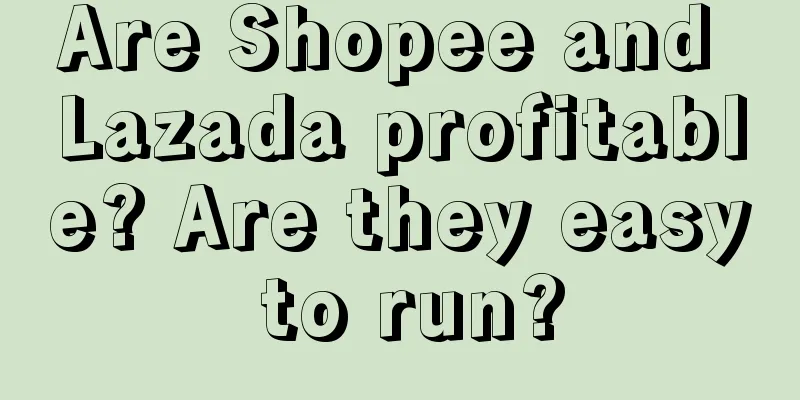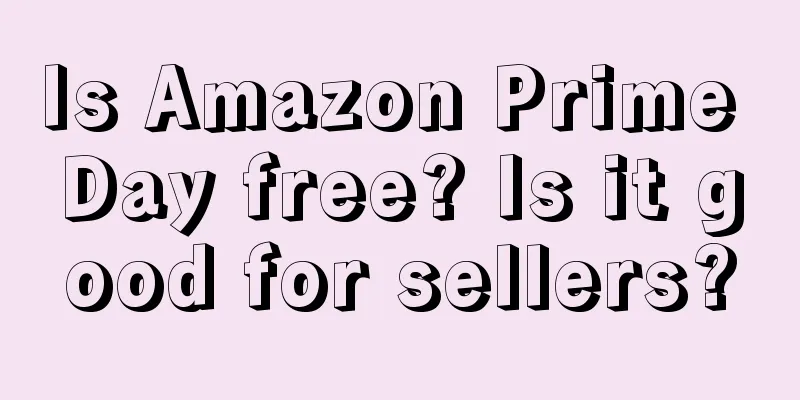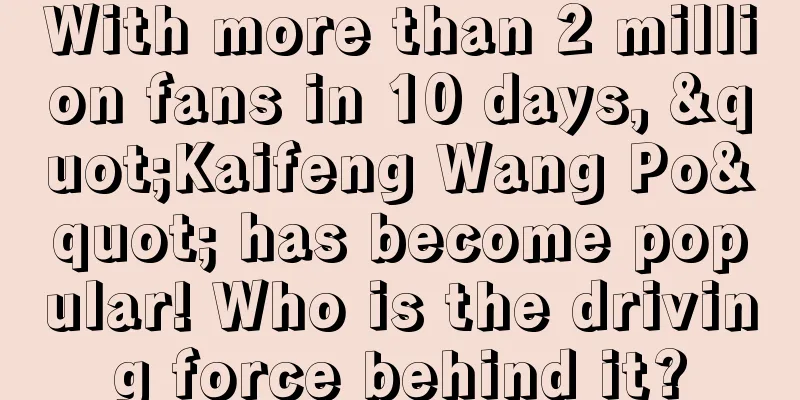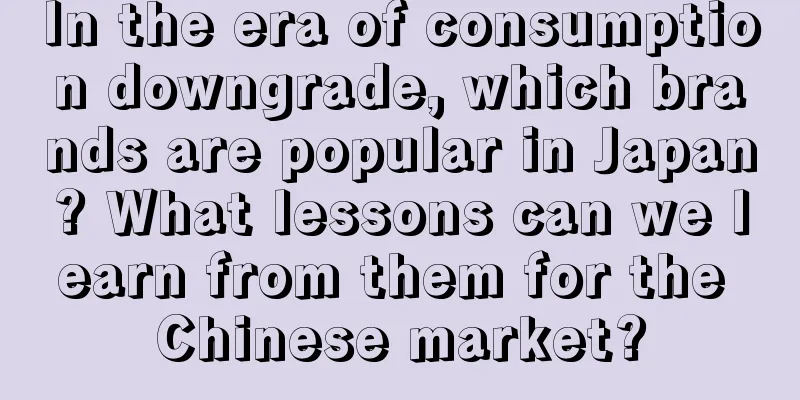Brand No. 1: 5 rules of business war between the second and the first
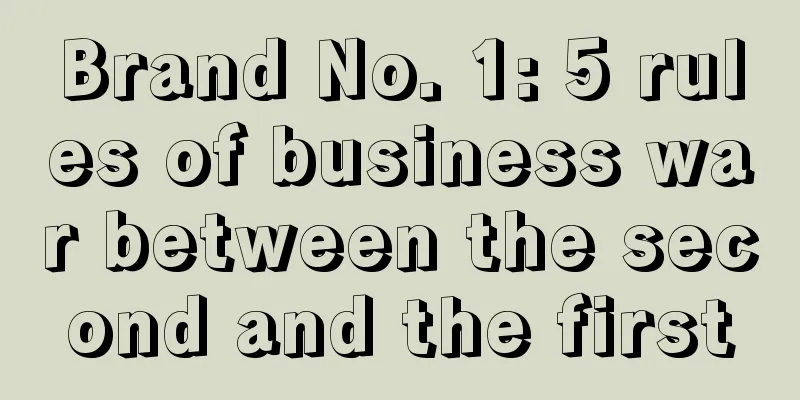
I don’t know whether there will still be Zhong Xue Gao 135 years later (it seems to have disappeared now), whether there will still be Xiao Xian Dun, or whether there will still be Ramen Shuo (it is said that it is not very ideal either), but the 135 years of Coca-Cola is worth learning for new consumer brands, and even Coca-Cola’s century-old marketing approach is worth redoing for new consumer brands. In other words, the key to understanding the laws of consumer product competition is to understand the history of consumer brands. The further you look into history, the clearer the present will be. Things develop in different stages, and different stages have different focuses. Only by finding the pattern can we grasp the key points... The development of brands also has its unchanging rules: from the product competition stage, to the channel competition stage, to the advertising competition stage, and finally to the mind competition stage. The four stages of brand competition correspond to product war, channel war, advertising war, and mind war. At different stages, the emphasis and combination of marketing 4P (product, price, channel, promotion) are different. Any organizational resources are relatively limited. In order to achieve targeted results under relatively limited circumstances, we must focus on the key points at different stages.
1. The Revelation of the Coca-Cola Business War1. Create a category name to achieve greater mental differentiationFrank Robinson led the early marketing of Coca-Cola, and he renamed it "Coca-Cola". New products need new names to attract attention and reduce negative perceptions (Coca-Cola was originally called CocaKola: Coca and Kola come from its two important ingredients, coca and kola nut). Under the leadership of Frank Robinson, Coca-Cola used advertising to increase its popularity (knowing), opened up channels (buying), and provided free drinks to enhance the experience (drinking). Knowing, buying, and experiencing, good wine is more afraid of being hidden in a deep alley. In the product competition stage, whoever can reach users first will be in a position to establish a cognitive advantage on the consumer side. Create a new category and give it a name that reflects its characteristics to achieve greater mental differentiation 2. Advertisement amplification and selling pointsRegardless of the form of advertising, two things remain constant: (1) Clearly convey product information (features, benefits, price). (2) Accurately express brand positioning (category, characteristics, brand position). At the beginning of a product category, consumers recognize brands through products, and the quality of the product experience will affect their evaluation of the brand. Advertisements should focus on the unique and differentiated selling points of products, emphasizing the unique value points brought by raw materials, processes, and technologies. Almost all brands you can see started with products when they first entered the market, and this was also the case with Coca-Cola in 1886. On March 29, 1886, Coca-Cola launched its first advertisement in the Atlanta Journal. Even now, this advertisement is not outdated at all. The three-part slogan tells consumers who I am (brand name), what is different (function, benefits) and where to buy it.
3. Channels, coverage and penetration
It turns out that the most effective thing is to give free drink coupons, which attract the first batch of original users and addictiveness. Therefore, Coca-Cola increased the intensity of free drink coupons. It even used the Atlanta city address book to mail the free drink coupons to potential consumers or entrusted traveling salesmen to deliver them.
4. Create hot sales and herd effectStandardization is the premise of scale-in 1916, the Coca-Cola bottle we see and are familiar with today has already appeared, and the shape of the Coca-Cola bottle has hardly changed in the next 100 years. What is a classic? Classic is the precipitation of time (the same is true for Moutai's Mao-shaped bottle, the precipitation of time) In 1917, Coca-Cola changed its slogan to "Three million bottles of Coca-Cola are sold every day". Eight years later, in 1925, it was changed to "Six million bottles of Coca-Cola are sold every day". If there was a ranking list at that time, Coca-Cola would have been the first one: Coca-Cola was far ahead in sales, and it created hot sales through publicity, driving up the popularity of the category. A survey in 1949 showed that more than 99% of Americans could recognize Coca-Cola by the appearance of its packaging alone. The Coca-Cola curved bottle was synonymous with Coca-Cola. Standardized products laid the foundation for Coca-Cola's globalization. Ubras launched the "one size" bra in August 2018. In the Ubras Taobao flagship store, the sales of this bra endorsed by Ouyang Nana reached more than 400,000 pieces, and 50,000 pieces were sold in 30 minutes during the Double Eleven period alone. Coca-Cola, 3 million bottles of Coca-Cola are sold every day; no size, hot sales of more than 5 million pieces - all the marketing is worth redoing. 2. The Second Child’s StrategyBuffett has always had a special liking for businesses that make addictive products. Coca-Cola, See's Candies, and Heinz, whose products include Oreo and Chewy, all contain a lot of addictive sugar. In his opinion, whether it is Coca-Cola containing cocaine or Coca-Cola that later removed cocaine and reduced the amount of caffeine, Coca-Cola is an excellent business. 1. Price war: same price, double the CokeIn 1894, pharmacist Caleb Bradham invented a cola drink containing pepsin. People initially only knew it as Bradham's drink. In 1898, Bradham changed the name to Pepsi-Cola in order to take advantage of the popularity of Coca-Cola. 100 years later, in 1998, Fanta Cola also came, and Pepsi-Cola was the most successful one. From the product level, they are both cola products. At first, consumers were unwilling to pay for a bottle of cola that was the same price and tasted similar but was not Coca-Cola. Even though they spared no effort in channels and promotion, they still could not find an effective way. (Coca-Cola is 5 cents for 6 ounces, Pepsi is 5 cents for 6 ounces)
As a latecomer, the first question to answer is: where do my customers come from? From competitors. Pepsi successfully converted price-sensitive customers among Coca-Cola users in the first stage through a 50% discount sales strategy. They have no preference for brands and are relatively sensitive to prices. Each party's basic foundation and fundamentals determine the basic strategy, which is to attack where it is not defensible. Similarly, in the battle for herbal tea, it also achieved a phased victory by offering larger bottles to satisfy the category leader. In other words, the most direct and effective way for a latecomer to attack a leader is to offer lower prices and more benefits. Because the market share of the leader is large, it is difficult to adopt a price follow-up strategy. Of course, the premise is that there is a cost advantage, or it is promoted one region at a time. It still requires specific problems and specific strategies. 2. Advertisement coverage: Just use it, don’t rack your brains to find a solutionAfter the price attack was successful, Pepsi began to further piggyback on Coca-Cola's traffic - actively standing next to the leader, and if you stand there for a long time, you will be the second. All of Pepsi's advertisements are trying hard to establish a strong association with Coca-Cola. In 1941, Pepsi's market share rose to 14% (Coca-Cola 46%). Iconoclastic writers Allen Kent and Austin Crumb wrote a breezy jingle, "Pepsi Is Good," to the tune of "Do You Know John Pearson?"
Pepsi-Cola made this song into a 30-second radio advertisement. After it received good results on the radio, it was adapted into an orchestral record. After that, the song was adapted into a march, waltz, rumba and country song, and was repeatedly circulated, at one point earning the evaluation of "a disaster to the American continent." After that, Mixue Ice City adapted "Oh, Susanna!" I love you, you love me~ Mixue Ice City is sweet; Miu Ke Landou adapted "Two Tigers" and changed the lyrics to "Miu Ke Landou, Miu Ke Landou, cheese sticks, cheese sticks, high in calcium and nutritious, growing up with me, really delicious, really delicious", and then played it repeatedly at the elevator entrance through Focus Media. With its continuous investment in Focus Media, it became the largest cheese company in China in two years, and its market value increased from more than 2 billion to more than 20 billion. Going further, Subor Learning Machine: You clap, I clap, Subor has launched a learning machine; You clap twice, I clap twice, we play games and learn together; You clap three times, I clap three times. It’s easy to learn; You clap four times, I clap four times, and I guarantee you will be able to type in three days. You clap five times, I clap five times, to lay the foundation for the future!
3. Coca-Cola strikes backFacing fierce competition from Pepsi, Coca-Cola was also led astray from its revolutionary path, especially in the blind taste challenge of Pepsi, where Coca-Cola even launched a lighter cola to suit consumers’ taste preferences. This is a typical example of being led by the opponent.
Products are easy to imitate, flavors are hard to satisfy, channels are for everyone, and if promotion is not based on differentiation, it is just a simple product display and product promotion information, which cannot enter the minds of consumers and become the first choice of the category. Facing competition from Pepsi, Coca-Cola started to build brand mind: Establish an emotional connection, happy emotions are a purchasing accelerator. Is Coca-Cola a healthy family beverage or a mild alternative to alcoholic beverages? Beyond the product level, Coca-Cola gave its own answer: "Enjoy the feeling of thirst while working or playing", which gradually evolved into the famous phrase "The Pause That Refreshes". Explore cultural symbols and parasitic scenes to reshape IP rendering emotional value. Faced with the obvious problem of off-season and peak-season for Coca-Cola products, in 1931, Coca-Cola selected Santa Claus to help boost Coca-Cola's sales. Christmas is a key marketing node, not only does the whole family get together, but also shares happiness with each other, which just fits the brand symbol of "happiness" that Coca-Cola has worked hard to create. Coca-Cola signed a contract with artist Haddon Sundblom to recreate the image of Santa Claus. Social psychology research shows that humans have a special preference for things that are familiar to them, and the degree of preference increases with the frequency of appearance. Social psychology calls this phenomenon the "exposure effect", also known as the law of familiarity. The more familiar, the more you like it, the more you like it, the more you trust it, and the more you trust it, the more you buy it.
4. Competition for positionFaced with this wave of brand operations by Coca-Cola, Pepsi realized that competition at the levels of price, product, channel and promotion is far from enough. It is necessary to establish its own brand position from the perspective of brand, the dimension of mind and the space of cognition - knowing the place of battle and the day of battle, so as to fight thousands of miles away. Faced with Coca-Cola's authentic, American, and happy attack, what would you do if you were PepsiCo with limited funds? There is only one answer: find a position that truly matches the company's actual and capable position.
5. Competition Question 21. Who are the competitors and what is the value? Competitors usually come from within the category. Unless you are the leader in the category, you may be able to expand into markets outside the category. At this time, you need to reposition yourself, because your competitors have changed from within the category to outside the category. When your competitors change, you naturally need to find new differentiated value points. 2. What position does it occupy? 1. Avoid the strong position of competitors in the minds of customers - the definition of strong and weak positions is in the minds of customers, not on the physical level. It is the cognitive position accumulated, formed and precipitated in the minds of customers. 2. Or take advantage of the weakness hidden in its strength - why not the weakness, but the weakness hidden in its strength. It is very important to choose the point of attack, and you have to attack where it cannot defend. Coca-Cola represents authenticity, which means tradition and classics. Pepsi-Cola hit the opposite of Coca-Cola: cola for young people. Baby boomers are the target customers of Pepsi-Cola. From 1946 to 1964, the number of newborns in the United States exceeded 78 million, and they were called "baby boomers". Kennedy proposed the concept of "new generation" in his inaugural address, referring to the "baby boomers" born after World War II. Pepsi (the cola for young people) resonates with young people by showing their lifestyle. This strategy has become the main line for Pepsi to fight against Coca-Cola for decades. The brand appeal of young people has increased Pepsi's domestic market share from 21% to 35%. Even in Atlanta, where everyone likes Coca-Cola, Pepsi's sales have increased by 30%. Conclusion
Author: Houshan Keju, Source: WeChat public account “Lao Gao Business and Brand”. |
<<: Five money-making tracks, find the opportunity that suits you
>>: User activity, retention, and churn, a very comprehensive illustration!
Recommend
These translators are the best copywriters in the world
In the world of advertising and marketing, the pow...
How to get a partial refund on Shopee Taiwan? What is the method?
There are more and more merchants opening stores o...
2023, the year of the explosion of new tea drinks going overseas丨Annual observation
Starting from tea drinks, this article analyzes th...
How to fill in Amazon tax information? What should I do if I fill in the Amazon tax information incorrectly?
As one of the world's largest e-commerce platf...
Can Amazon ship without VAT? How to do it?
In recent years, the topic of cross-border e-comme...
The card game craze of the post-2010s: addiction, comparison and social interaction
Recently on TikTok, live broadcasts of “unpacking ...
What problem should the brand solve?
Brand is not only a bridge between enterprises and...
How to sell products on cross-border e-commerce platforms? How to choose categories?
With the development of globalization and digitali...
What single-plank bridge is Video Account walking on?
With the support of WeChat, how much commercial va...
How long will it take for a Shopee account manager to contact you? Why can't I find an operations manager?
Shopee, like Amazon, is a cross-border e-commerce ...
What products are suitable for selling on the Wish platform? What should I pay attention to when uploading products?
When we choose a platform to sell things, we need ...
How to retrieve Shopee main account? How to do it?
Now many entrepreneurs have joined the cross-borde...
Amazing! Accurately attract more than 650 people a day, the latest and most efficient way to promote WeChat public accounts
This article will share a set of proven methods fo...
There are still growth opportunities. Here are 6 tips on how to provide Douyin life services well.
How to provide a good service for Douyin life? Thi...
When going out during the May Day holiday, should you trust Dianping or Xiaohongshu?
Is it difficult to choose food and scenery during ...

